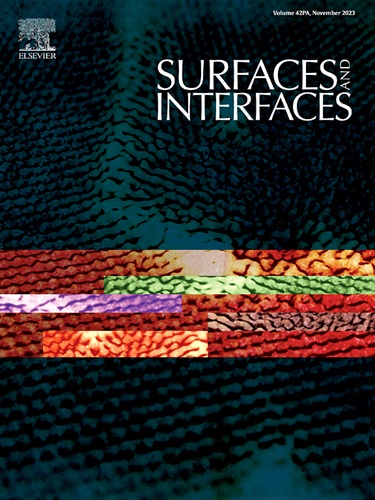Flexible switch between photocatalysis and electrocatalysis for CO2RR by stacking mode
IF 5.7
2区 材料科学
Q2 CHEMISTRY, PHYSICAL
引用次数: 0
Abstract
In recent years, a large amount of carbon dioxide (CO2) emission has caused serious environmental pollution and energy crisis. Searching for the suitable materials for carbon dioxide reduction reaction (CO2RR) is a key step to achieve environmentally friendly reduction of greenhouse gas emissions and achieve carbon neutrality. In this paper, the results show that the Boron Arsenide (BAs) monolayer has excellent electrocatalytic performance, and the limiting potential is only 0.27 V for CH4 formation by electrocatalytic CO2RR. Constructing BAs/PtTe2 heterostructure greatly reduces the Gibbs free energy in the catalytic process, but the catalytic path is changed at the same time, and the limiting potential for the formation of CH4 increases to 0.42 V. The interesting finding is that the BAs/PtTe2 heterostructure can meet the demand of photocatalytic CO2RR for producing CH4. At the same time, the production of HCOOH is filtered out under photocatalysis due to its just-right band edges. Then, natural light can be used to complete the half-reaction of carbon dioxide reduction as a green and sustainable energy source. This study provides strategic insights for the design and development of catalysts for CO2RR.

CO2RR的光催化和电催化可通过堆叠模式灵活切换
近年来,大量的二氧化碳(CO2)排放造成了严重的环境污染和能源危机。寻找合适的材料进行二氧化碳还原反应(CO2RR)是实现环境友好型减少温室气体排放,实现碳中和的关键一步。研究结果表明,砷化硼(BAs)单层具有优异的电催化性能,电催化CO2RR生成CH4的极限电位仅为0.27 V。构建BAs/PtTe2异质结构大大降低了催化过程中的吉布斯自由能,但同时改变了催化路径,CH4生成的极限电位提高到0.42 V。有趣的是,BAs/PtTe2异质结构可以满足光催化CO2RR生成CH4的要求。同时,由于HCOOH的带边刚好,在光催化作用下,HCOOH的生成被过滤掉。然后利用自然光完成二氧化碳还原的半反应,作为一种绿色可持续的能源。该研究为CO2RR催化剂的设计和开发提供了战略见解。
本文章由计算机程序翻译,如有差异,请以英文原文为准。
求助全文
约1分钟内获得全文
求助全文
来源期刊

Surfaces and Interfaces
Chemistry-General Chemistry
CiteScore
8.50
自引率
6.50%
发文量
753
审稿时长
35 days
期刊介绍:
The aim of the journal is to provide a respectful outlet for ''sound science'' papers in all research areas on surfaces and interfaces. We define sound science papers as papers that describe new and well-executed research, but that do not necessarily provide brand new insights or are merely a description of research results.
Surfaces and Interfaces publishes research papers in all fields of surface science which may not always find the right home on first submission to our Elsevier sister journals (Applied Surface, Surface and Coatings Technology, Thin Solid Films)
 求助内容:
求助内容: 应助结果提醒方式:
应助结果提醒方式:


